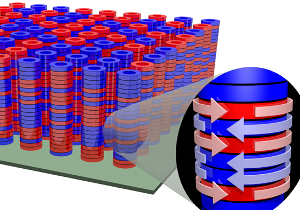Spintronics has become a mature technology for applications, such as magnetic field sensing and solid-state memories. However, existing concepts are almost exclusively based on planar processes such as thin film deposition and patterning. Extending spintronics to 3D devices would provide new integrated functionalities such as three-dimensional magnetic field sensors, and also open prospects for an increase of data retention or capacity for future generations of solid-state memories.
The position is open in the framework of C3DS, a binational French-German ANR-DFG project. The purpose of C3DS is to develop and demonstrate the functionality of basic spintronic building blocks suitable for 3D integration. We will use the tubular geometry, compatible with deeply-3D integration in vertical pores, and which allows core-shell structures to be obtained as required to achieve spintronic effects. We target both the demonstration of various magnetoresistance effects, and controlled and efficient domain-wall motion along such tubes. Besides opening prospects for novel devices, the project addresses exciting fundamental aspects such as magnetism in curved geometries.
Objectives
The post-doctoral fellow will be responsible of nanofabrication for electrical contacting, dc and ac electrical measurements including combined with magnetic force microscopy in the lab, and will be largely involved in TEM imaging with magnetic modes, and XMCD and STXM magnetic imaging at synchrotron facilities. She/he will also be interacting closely with the German partners in charge of chemical synthesis, and those Grenoble colleagues developing micromagnetic models and conducting micromagnetic simulations. She/He may be involved in the supervision of Master students and PhD candidates. Participation to international research schools and conferences is encouraged and will be supported.
Working environment
The fellow is inserted in a larger action on magnetic nanowires and nanotubes conducted in the spin textures team, involving in Grenoble researchers and young scientists from Spintec laboratory, Institut Néel and beyond. As such, while having a well-defined independent topic, she/he will benefit from a collaborative environment with weekly group meetings and support from other members. Close contact is expected with the two chemist expert groups in Darmstadt and Erlangen (Germany), with regular working meetings, and the possibility of short-term stays. The Spintec and Institut Néel boast a large critical mass in nanomagnetism and spintronics, providing an efficient and stimulating environment with many experts, internal meetings and seminars. More generally, Grenoble is a recognized hub for condensed matter physics. It is also a lively international place, with endless possibilities for outdoor activities.
Salary
The salary is provided through CNRS. The exact duration (circa 30 months) and gross salary (starting from 2530€ for just-graduated PhDs) depend on the carrier stage of the fellow. The candidate will benefit from CNRS workers conditions, such as subsidized local transportation and privileged access to sporting activities.
Application
Applicants must have a PhD diploma with expertise in one or several of these fields: nanomagnetism/spintronics, clean-room facilities, electrical measurements. They should display taste for experimental physics and collaborative work, with good understanding of condensed matter physics. Applications must include a CV, motivation and recommendation letters, and be posted at this link: http://bit.ly/2CcSD2x. The position is readily available and should be filled as soon as possible. The contract is expected to start on May 1st, taking into account the selection process, hiring procedures, and security request to access SPINTEC.
More information
- Project PI: Olivier FRUCHART (olivier.fruchart@cea.fr).
- Team: Spin textures
[1] Three-dimensional magnetism, A. Fernández-Pacheco, O. Fruchart et al., Nat. Comm. 8, 15756 (2017). [ DOI: 10.1038/ncomms15756 ]
[2] Magnetic nanowires and nanotubes, M. Staňo, O. Fruchart, in: Handbook of magnetic materials vol.27, Ed. Ekkes Brück, Elsevier. [ DOI: 10.1016/bs.hmm.2018.08.002 ]
[3] Imaging flux-closure domains and domain walls in electroless-deposited ferromagnetic nanotubes, M. Staňo, O. Fruchart et al., SciPost Physics 5 (4), 038 (2018) (DOI: 10.21468/SciPostPhys.5.4.038)

